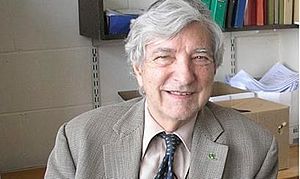Alan R. Katritzky facts for kids
Quick facts for kids
Alan Katritzky
|
|
|---|---|

Alan Roy Katritzky FRS
|
|
| Born |
Alan Roy Katritzky
18 August 1928 |
| Died | 10 February 2014 (aged 85) |
| Nationality | British, American |
| Alma mater | St Catherine's College, Oxford Trinity Hall, Cambridge |
| Spouse(s) | Agnes Juliane Dietlinde Kilian (Linde) |
| Awards | FRS |
| Scientific career | |
| Institutions |
|
| Doctoral advisor | Sir Robert Robinson |
Alan Roy Katritzky (born August 18, 1928 – died February 10, 2014) was a very important chemist. He was born in Britain but also became an American citizen. He worked at the University of Florida later in his life. Katritzky was a pioneer in a special area of chemistry called heterocyclic chemistry. He helped explain and develop this field a lot.
Contents
Alan Katritzky's Early Life and School
Alan Roy Katritzky was born in Harringay, England, on August 18, 1928. His father, Frederick Charles Katritzky, was a tailor. His mother was Emily Catherine Lane.
In 1940, when he was 12, Alan was sent away from his school. This was during World War II. He went to Wisbech in Cambridgeshire. There, his chemistry teacher, W. E. Fieldhouse, made him love chemistry.
When he returned home, he made his own chemistry lab. On his 15th birthday, he created his first heterocyclic compound. This was a medicine called Veronal.
After serving in the military for 18 months, he went to St Catherine's College, Oxford in 1948. He earned a top degree. Then, he got his DPhil (a high-level research degree) in 1954. His research was about the structure of strychnine. His supervisor was Sir Robert Robinson.
Katritzky's Amazing Chemistry Career
After finishing his studies, Katritzky stayed at Oxford. From 1954 to 1958, he led a small research group. He mainly studied chemicals called pyridines.
In 1958, he moved to Cambridge University. He became one of the first members of Churchill College, Cambridge. In Cambridge, he kept studying pyridines. He also started looking into other areas. One new area was NMR. This method helped him learn about chemical structures. It was special because it did not harm the sample. In 1963, Cambridge University gave him a DSc degree. This is a very high honor for a scientist.
Leading a New Science School
When he was 34, Alan Katritzky became a chemistry professor. He also became the head of a new science school. This was at the UEA. He wanted to lead a school focused on chemical sciences. Many people disagreed with him. But famous scientists like Alexander Todd supported him. He won the argument.
He worked hard to create new courses for students. He also designed and built new labs. He hired about 25 professors. All this was while he continued his own research. During this time, he helped us understand aromaticity. This is a special property of some chemical compounds. He also studied how chemicals react.
In 1967, he helped create the Heterocyclic Group. This was part of the Chemical Society. In 1980, he was chosen as a Fellow of the Royal Society (FRS). This is a very important honor in science. His time at UEA was very successful.
Moving to the United States
By 1980, Katritzky felt he had too much administrative work. He realized that if he stayed in the UK, retirement was coming soon. So, he accepted a special research job in the United States. He became a professor at the University of Florida. This job meant he could focus only on research. He did not have to teach undergraduate students.
This was another very productive time for him. He started the Florida Center for Heterocyclic Compounds. He also created a computer program called Codessa Pro. This program helps scientists understand chemical structures. He also researched how to use benzotriazoles. These are chemicals used to make interesting compounds for biology.
Throughout his career, he guided over 300 graduate students. He also worked with more than 500 visiting professors and researchers. People described him as strong and direct in his work. But they also said he was kind and warm in his personal life.
For many years, Katritzky traveled the world giving lectures. He also worked as a consultant for 32 companies. These companies were in Europe and North America. He could give lectures and answer questions in German, French, and Italian. He often worked with the British Council. He also worked with national science academies. Two companies he advised were 3M and Pfizer. He worked with 3M for a long time. He visited their offices in St Paul, Minnesota, and their labs in Harlow, England. He also visited their company in Savona, Italy.
Awards and Honors
Alan Katritzky's work was recognized all over the world. He received 33 honorary doctorates or professorships and many awards. Some of his awards include:
- Tilden Medal of the Royal Society of Chemistry (1975)
- Fellow of the Royal Society, England (1980)
- Fellow of the American Association for the Advancement of Science (2000)
- Cope Senior Scholar Award of the American Chemical Society (2002)
- Robert Robinson Lectureship (2009)
Family Life
Alan Katritzky met Agnes Juliane Dietlinde Kilian (Linde) in 1949. They met while skiing in Germany. They got married in Munich on August 5, 1952. They had four children: Margaret, Erika, Rupert, and Freda.

